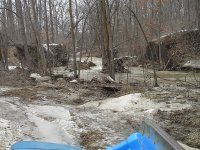I'm stumped about the best option to go with. Been reading several threads on creek crossing but none with my type of situation. I live on 65 beautiful acres. My homestead sits on 22 acres of it. 43 acres are on the back side of a creek with the name Bodan Creek. It's a major creek that feeds the neches river which is about. 5 miles from my house.
My wife and I inherited the place 28 years ago from her grandmother.
A little history on Bodan Creek. Several farmers have rented the place before we got it. So all they would do is bulldoze the crossing. It has a pretty good slope on one side but it's clay and very slick when wet. The other sorta sets in a bend. It keeps a steep slope because of how the water flows and is sandy mix and can stick a tractor if not careful. The banks on Bodan is roughly 12-15 ft deep depending on where you stand. It's about 20 ft wide at the crossing.
Thought about a ford but after the recent rains it's 3-4 ft deep now. I've had 4, 4x5 concrete coverts that the county gave me. They worked well but when the spring rains came they always washed out.
I use a Long 460 two wheel drive tractor. So a box blade is about it as far as dirt moving goes.
So.... What would you do?
My wife and I inherited the place 28 years ago from her grandmother.
A little history on Bodan Creek. Several farmers have rented the place before we got it. So all they would do is bulldoze the crossing. It has a pretty good slope on one side but it's clay and very slick when wet. The other sorta sets in a bend. It keeps a steep slope because of how the water flows and is sandy mix and can stick a tractor if not careful. The banks on Bodan is roughly 12-15 ft deep depending on where you stand. It's about 20 ft wide at the crossing.
Thought about a ford but after the recent rains it's 3-4 ft deep now. I've had 4, 4x5 concrete coverts that the county gave me. They worked well but when the spring rains came they always washed out.
I use a Long 460 two wheel drive tractor. So a box blade is about it as far as dirt moving goes.
So.... What would you do?

